Caen appointed club legend Nicolas Seube as their new head coach only in November last year after sacking renowned Ligue 2 promotion specialist Jean-Marc Furlan earlier that month, with the team placed 12th in Ligue 2, far from the desired promotion spots. That worsened under caretaker boss Patrick Sauvaget, with the Vikings floundering in 16th, giving their next permanent boss an unenviable task.
However, Seube has not only met the challenge head-on but has drastically improved Caen‘s outlook for the season. With five wins and a draw in his six league matches in charge, the club now incredibly occupy the final promotion playoff spot (fifth) in Ligue 2 — only four points behind third-placed Grenoble Foot.
How has Seube turned things around in such a short span of time? This tactical analysis will take a deep look at the data behind Caen’s upturn under their legendary former midfielder as well as providing an analysis of their tactics in and out of possession.
Background
Nicolas Seube began his playing career at Toulouse, moving from their B team to the senior side in 2000. However, he didn’t make a single appearance for the first team before joining Caen on a free transfer the following summer.
At Caen, he found a home he would inhabit for 16 years. Seube went on to become a regular starter for the Vikings, who were then in Ligue 2 and helped them win promotion to the first tier in 2004. However, they suffered relegation at the end of the 2004-05 campaign, spending two more seasons in the second tier before returning to Ligue 1 in 2007. They stayed up for two campaigns before suffering relegation once again.
Caen were back in Ligue 1 in 2010, went back down in 2012, were promoted in 2014 and remained in the top flight until 2017 when Seube announced his retirement. Overall, he made 520 appearances for the club, recording 10 goals and 12 assists. While he largely operated in defensive midfield, he also played as a left-back and centre-back when required.
He holds their appearance record and is 109 ahead of second-placed Anthony Deroin. Among active players currently at Caen, Alexandre Mendy comes closest to Seube with 125 appearances, still a considerable distance away. Seube is also the second-oldest player to play a match for the club at 37 years, eight months and 19 days, and their oldest-ever goalscorer, having netted in a 3-2 win over Olympique Marseille back in 2015 at the age of 35 years, six months and 16 days.
A year after his retirement, Seube joined Caen’s U19 side as their assistant manager before taking on the same role on their B team in 2019. One year later, he became the U19 team’s manager, a position he held for two years while also managing their academy team between 2021 and 2023. Midway through that stretch, Seube became Caen B’s manager in July 2022 and held that role until November 2023, when he was appointed as the manager of the senior team.
Talk about a one-club man!
How Caen have set up under Seube
Across his first six matches in charge of Caen, Seube has stuck with a 4-4-2 formation.
In the first four games of his tenure, he chose to use Anthony Mandrea in goal but has since shifted to Yannis Clementia. Centre-backs Brahim Traoré and Romain Thomas (who is also their captain), centre-forward Alexandre Mendy and midfielder Mathias Autret, who has played on both flanks so far, are the only players to have featured in all six matches.
Valentine Henry has largely made the right-back slot his own, though Seube handed Alexander Coeff a start in their most recent outing, a 2-1 win over Bastia. The left-back slot has been a toss-up between Coeff, Ali Abdi and Dieudonne Debohi, who started against Bastia.
Debohi and 19-year-old Noé Lebreton have largely been preferred in midfield, though Quentin Daubin and Hianga’a Mbock have also sparingly featured. Godson Kyeremeh has mostly accompanied Autret, though the likes of Henry, Abdi and Bilal Brahimi have also received minutes across either wing. Upfront, Mendy has had a variety of partners, including Autret, Mickaël Le Bihan and Brahimi.
The 4-4-2 set-up has given Caen a solid defensive identity, with the players out wide often tracking back to help the team defend in numbers. Since Seube’s arrival, they have only conceded twice, keeping four clean sheets in six outings. This has meant that they’ve picked up five wins and a draw despite scoring only seven goals.
On that note, let’s take a deeper look at what’s behind their resurgence under Seube.
What do the stats say about Caen’s improvements under Nicolas Seube?
Under Seube, Caen have made some improvements across the board, but many of their overall metrics have remained the same.
Let’s first take a look at their season averages (which includes Seube’s time in charge) in defensive metrics in comparison with their numbers in the six games since his arrival.
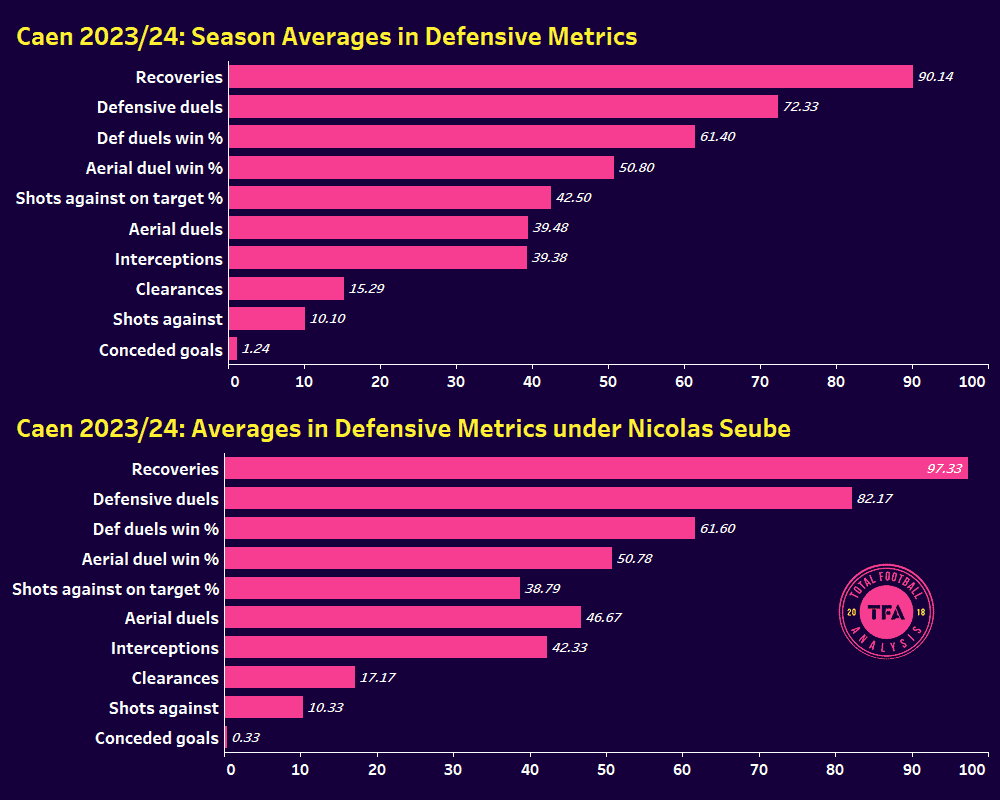
They are making more recoveries (97.33 compared to 90.14) and interceptions (42.33 from 39.38), with marginal improvements in clearances as well. While they are conceding slightly more shots (10.33 from 10.10), they have limited their opponents to an accuracy of just 38.79% compared to the season average of 42.50%, which partly explains their improved defensive acumen.
Next up, here’s a look at their passing, creativity and pressing intensity.
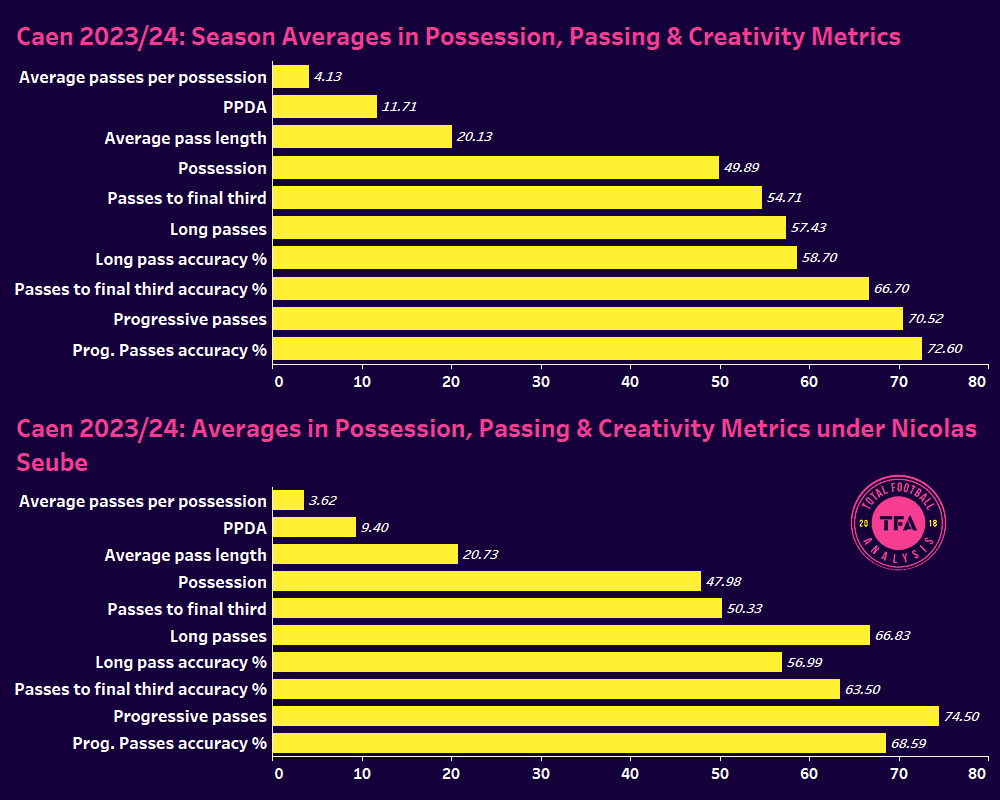
With the ball, Caen are now averaging fewer passes (3.62 from 4.13) and lesser possession (47.89 from 49.89). They have shown improvements in the number of long passes, which is up to 66.83 at more or less similar accuracy (56.99 compared to 58.70). Seube has also gotten them to average more progressive passes (74.50 compared to 70.52). This, along with their shift to a better pressing system (9.40 passes per defensive action compared to 11.71), should help their attacking prospects going forward as well as contributing to the aforementioned defensive metrics.
Speaking of attack…
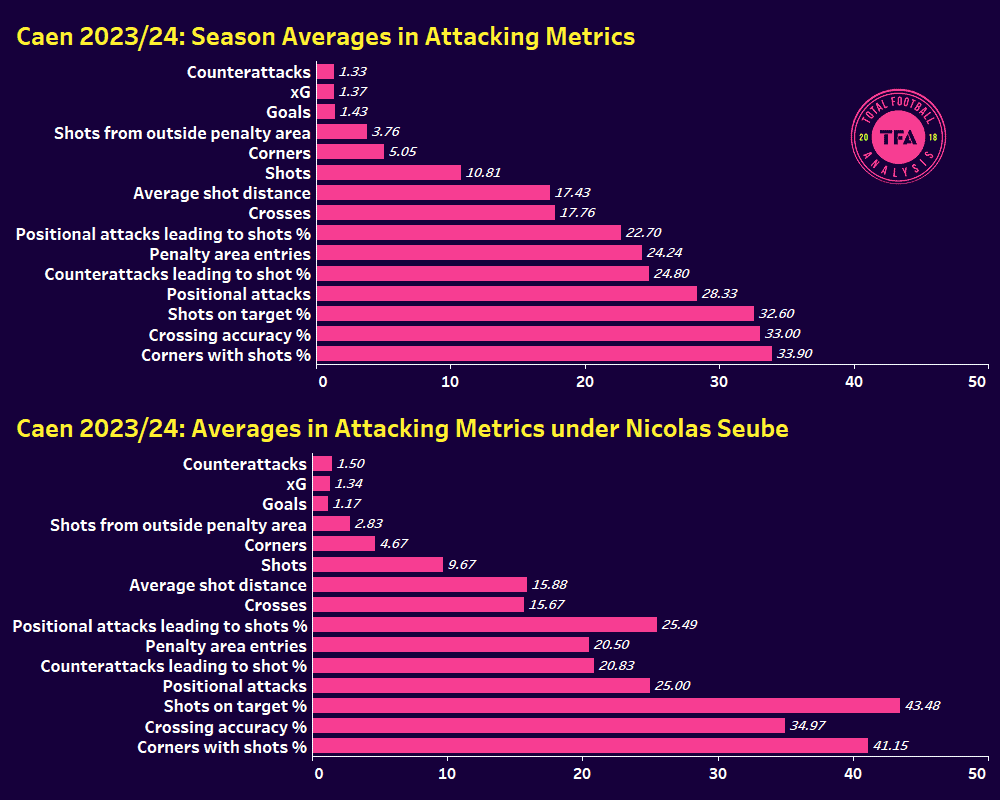
While they have scored only seven goals in six Ligue 2 games, Seube has already helped Caen make a few key improvements in attack. Their expected goals figure is 1.34, which they are only marginally underperforming – a trend across the season as a whole. However, their average shot distance is down to 15.88 from 17.43, and they’re getting substantially more shots on target, likely as a result of that (43.48% accuracy compared to 32.60%).
The frequency of their penalty area entries has dropped, but more of their positional attacks are leading to shots (25.49%, up from 22.70%). Perhaps most interestingly, they are winning fewer corners but are getting a shot away at the end of these corners way more often (41.15%) than their season average (33.90%).
These improvements have majorly contributed to Caen’s unbeaten run under Seube, who has returned to basics to make his team far more efficient across the pitch.
Attacking shape & output – Caen’s goals under Seube
Out of the seven league goals Caen have netted under Seube, four have been scored by Alexandre Mendy, while Autret, Brahimi and Mbock have contributed one each. Before we dive into some of those, let’s look at their shape during build-up.
As mentioned earlier, Caen have consistently used a 4-4-2 formation under Seube. However, they have also adapted well to in-game situations and modified their approach according to the opponent in terms of pressing and build-up patterns.
Consider this sequence from their 1-0 win over Concarneau. When the ball is with the centre-backs, both full-backs are hugging their touchlines while the holding midfielders drop between opposition attackers to receive passes. As the ball is played out to the left, we see the wide midfielders/wingers (marked in black) from both sides drop into midfield to provide passing outlets.
Later in the sequence, with the defence still in possession, we get our first glimpse at one of the two attackers (marked in red) dropping back as well. Lastly, with the ball played out to the left-back again, the left-winger prepares for a run forward, making him the player furthest forward.
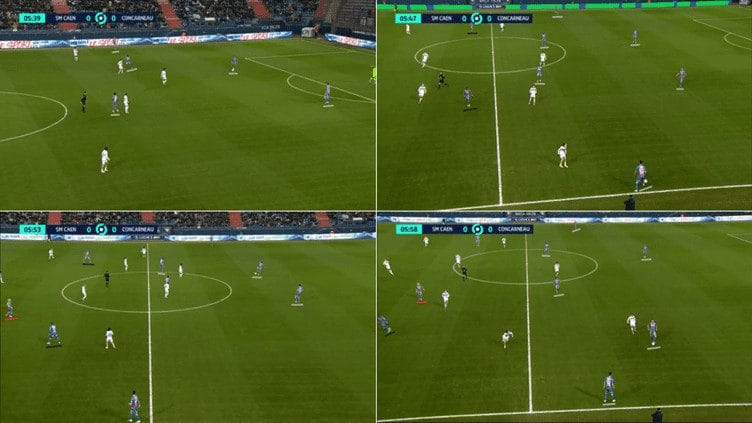
Now, let’s see what they do when they move further up the pitch. In this play against Amiens, the centre-back is allowed to carry the ball forward. Notice that a holding midfielder, left-winger, one of the attackers and the left-back move almost uniformly, spreading the field out and keeping opposing defenders on their toes.
The ball is played to a midfielder, and when this pass is played, the right-sided attacker alters his run while the right-back is furthest forward along the touchline, giving him options. However, he has time to measure a cross and sends a good one towards his man in the box, who gets the header away after moving between the centre-backs. Unfortunately, it flies just over the crossbar.

The last element Caen has had in attack under Seube is the ability to go route 1 when they face opponents who press them high. Alexandre Mendy, at 184 cm and 86kg, is a dominant presence who can ward off his marker to win the first ball, in addition to also being an effective passer. He is surrounded by midfielders and attackers who have an eye for open space.
All of this comes together in this sequence from their latest 2-1 win over Bastia. As the goalkeeper boots this long, Caen’s set-up is interesting. Mendy is initially the furthest forward but drops back to win the ball before feeding it to his teammate, who darts forward at the same time. Two headed passes later, they find the other centre-forward, who spreads a pass to the onrushing right-back, who starts this move in midfield but recognises that he has acres of space to exploit.
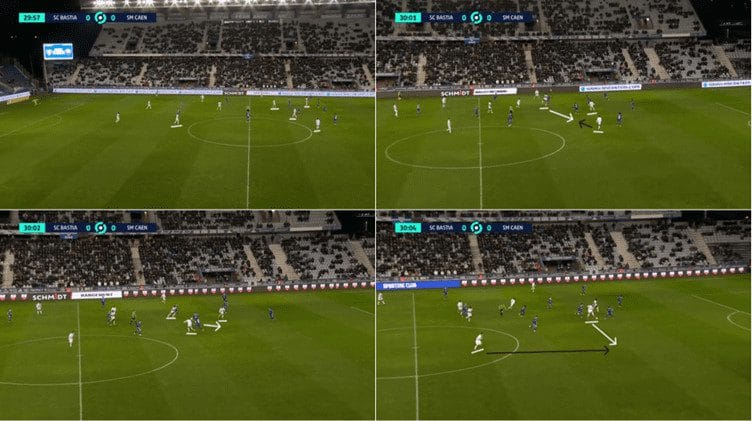
The off-the-ball movement helps Caen create a genuine attack despite initially being outnumbered by the Bastia defence.
Once the right-back gets the ball, he cuts inside to avoid a slide tackle, and by this time, a few more Caen players have sprinted forward. He then switches it to the left flank, from where the attacker sends in a first-time cross. It just evades one of his teammates before being cleared by a Bastia defender.
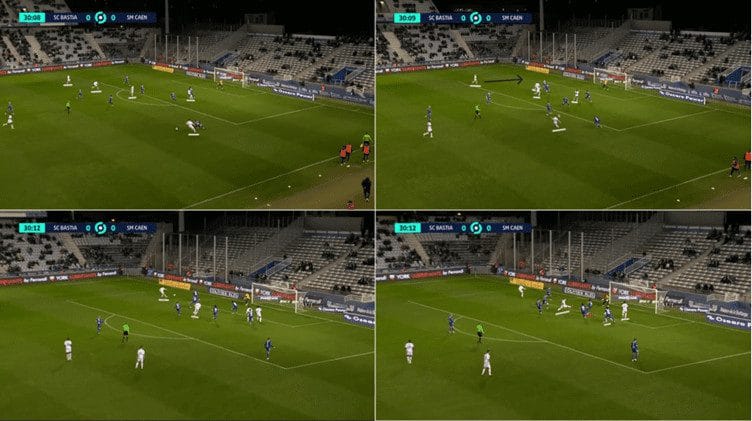
Lastly, as mentioned in the data section, Caen are more vicious when they attack corners. They have adopted an interesting strategy under Seube, where they begin their run from the edge of the box and move to both the near and far post, often devoting just one player to the central areas. This initially led to many of their corners ending up in the goalkeeper’s hands if he was brave enough to step out, but it also caused chaos.
In this example from their match against Bastia, they get the header in close to the near-post with a player waiting at the far-post, but the defender is alert and clears it away.
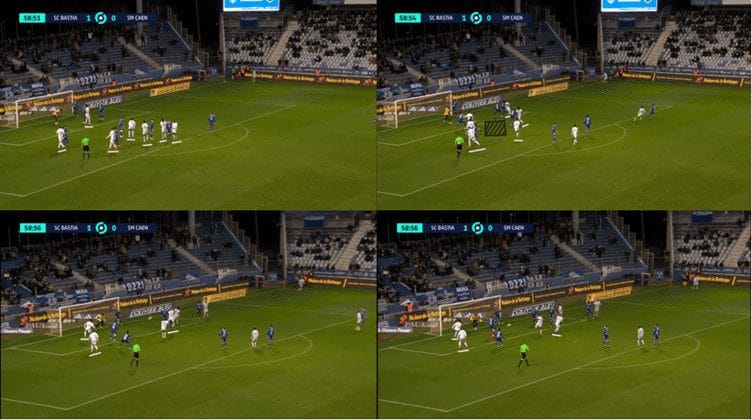
This is in contrast to the sequence below from their win over Concarneau, where the flick-on does reach a teammate and leads to a shot at the far post, which goes inches wide of the woodwork.
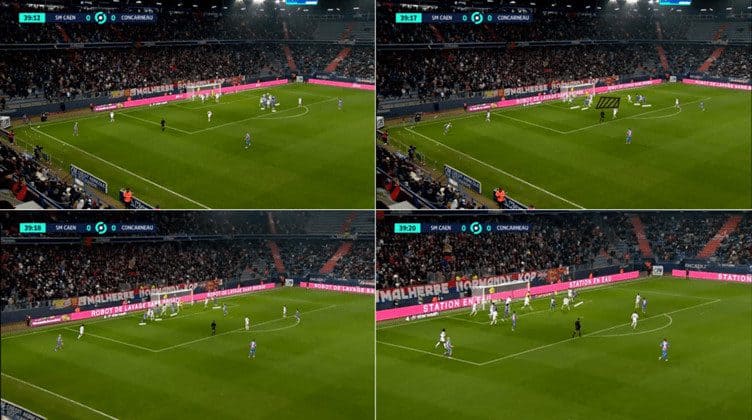
Caen’s attacks under Seube are thus defined by a willingness to commit men to the attack, variety and a splash of spontaneity when needed. The Vikings are a threat from build-up, long balls and corners, while their pressing (which we will look at below) also allows them to force turnovers in dangerous areas.
As mentioned earlier, Mendy has been Caen’s focal point in attack. Having already scored 10 times in Ligue 2 this term prior to Seube’s arrival, he has merely carried that form over, netting four goals in six matches (one penalty).
Mendy’s goal against Bastia gives an inkling into how Caen’s pressing in the middle third and ability to capitalise on errors can lead to chances. Here, they win the ball on the left close to their halfway line and move it forward before squaring it to Mendy, who escapes his marker to score with a simple finish.
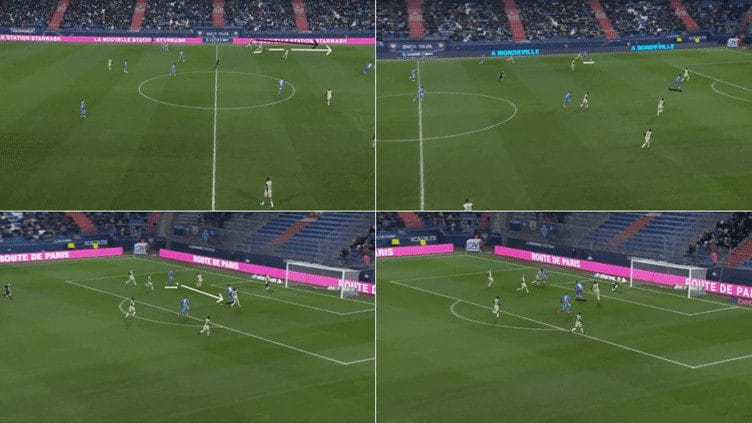
Meanwhile, his goal against Concarneau comes from Caen deploying an aggressive press further up the pitch. Seube instructs his team to apply pressure on the ball and they do so, but Concarneau initially seem to handle it well. However, in their first real attempt to progress the ball, their player overhits the pass under pressure, forcing a turnover in midfield. Two passes later, Mendy is sent through on goal and slams the ball past the goalkeeper.
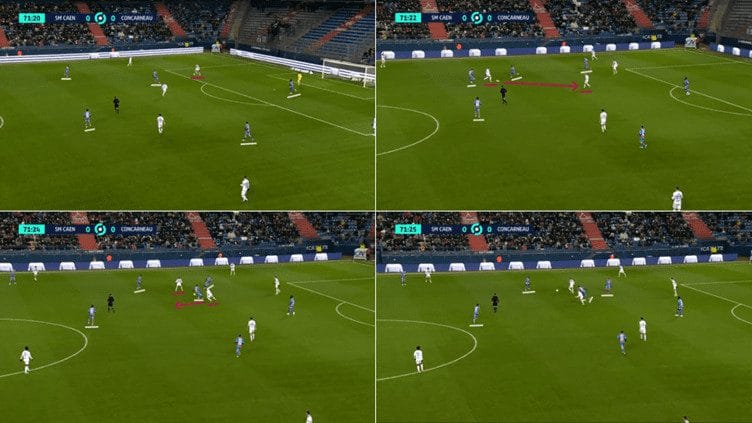
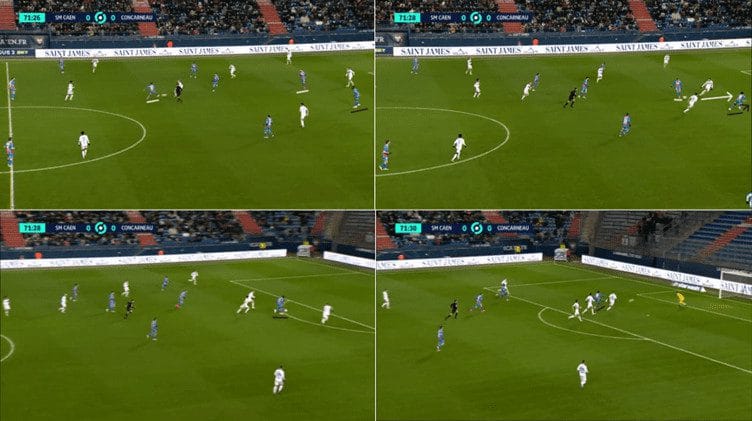
Among the remaining five goals, one came amid the chaos that ensued after a corner (scored by Mbock), and another was a penalty. Two of the other goals were on the counter, including the one below scored by Autret against Annecy.
Here, the opposition give the ball to Caen and they immediately flood men forward. The ball is played out to the right, and the right-back curls a cross in with four men to aim at. Autret, despite being the shortest man there, decelerates well to just drop behind a defender to get the header in and guides it past the goalkeeper to score what proved to be the game-winner.
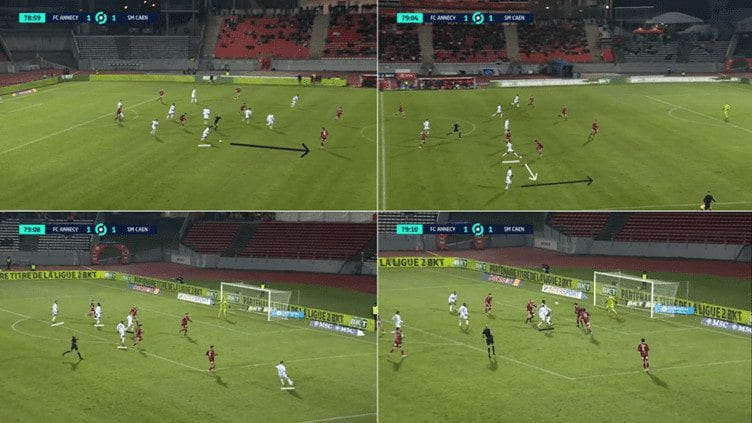
Caen’s counter-attacking numbers under Seube are low at 1.50 per game. However, the trends indicate that that number will grow during the season, making them a threat on yet another level apart from those listed above.
Defensive shape: Ball pressure and a high line
As their attacking patterns indicate, Caen under Seube tend to press high, with a system based on on-ball pressure. The attackers don’t press the goalkeeper too often; rather, the opposing centre-backs or defensive midfielders attract more pressure, allowing Caen’s second line of defence to close down space in midfield. The Vikings’ defensive line is fairly high, which has left them susceptible to balls over the top and in behind at times. However, they boast a decent recovery pace and have done well to make up for the same when needed.
All of this can be seen in the sequence below from their match against Dunkerque. In the bottom-left tile, it’s worth noting that if Dunkerque plays the ball to the midfielder, he actually has acres of space to run into. However, the constant ball pressure forces him to go back, and they have to move the ball from the defence once again.
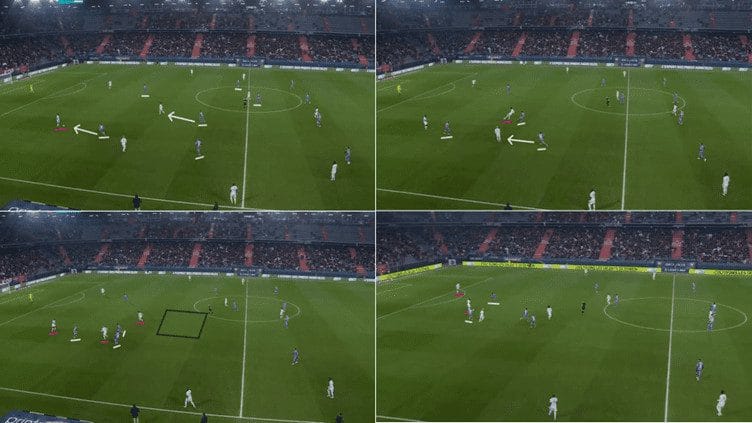
In the same sequence, we see more of the same pressure, this time out wide. Dunkerque deal with it better and once again, a player (the left-winger) has space to run into if the midfielder is able to find him. This is a difficult pass to make, though, and the attempt fails, with his pass ending up with the Caen defence.
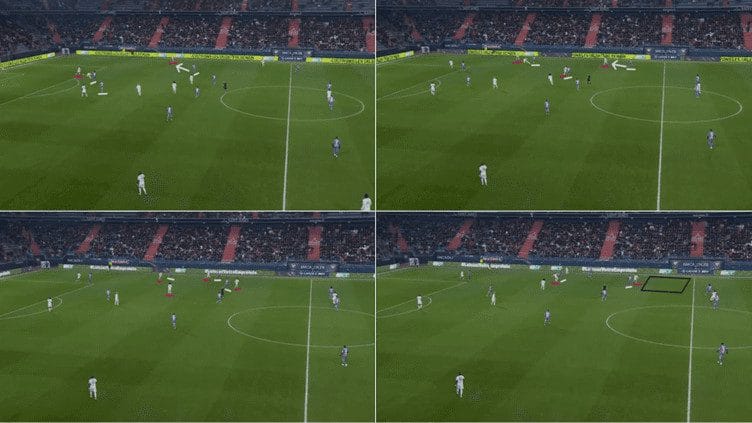
In a microcosm, this is how Caen’s defence under Seube shifts opposing teams onto the backfoot. They press high, confident that they can win the ball back despite leaving some space behind that opponents could exploit.
When the opponent does break through the first line of defence, let’s take a look at how Caen deal with it, as in this sequence against Concarneau.
After initially going long, Concarneau build the play from the back with some crisp passing down the right, this time finding the open man. This helps easily move into Caen’s half and construct an attack, leaving the Vikings’ initial defensive lines in a bit of a stir. However, in the bottom-right panel, it’s evident that they are scrambling back to cut out the spaces, demonstrating the recovery skills touched upon earlier.
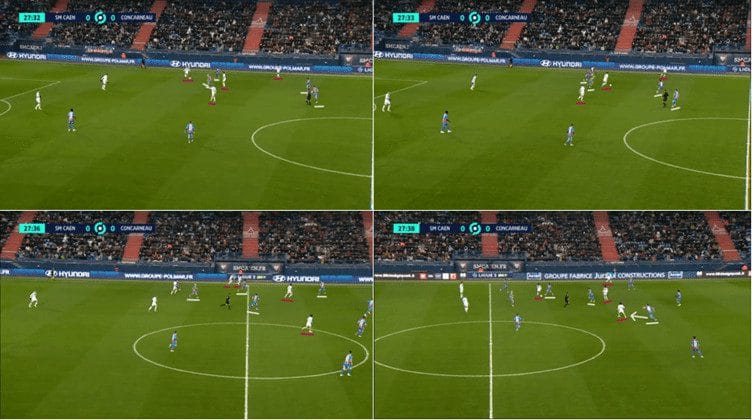
This leads us into the second phase of this play, where Caen actively work on cutting out the open spaces. Concarneau almost give the ball away under pressure with the first pass but somehow recovered to move the ball to the right. He has to initially drop back but looks up and cleverly slips it in behind the second defensive line to an attacker, but a Caen defender presses up to tackle him and put the ball out for a throw-in.
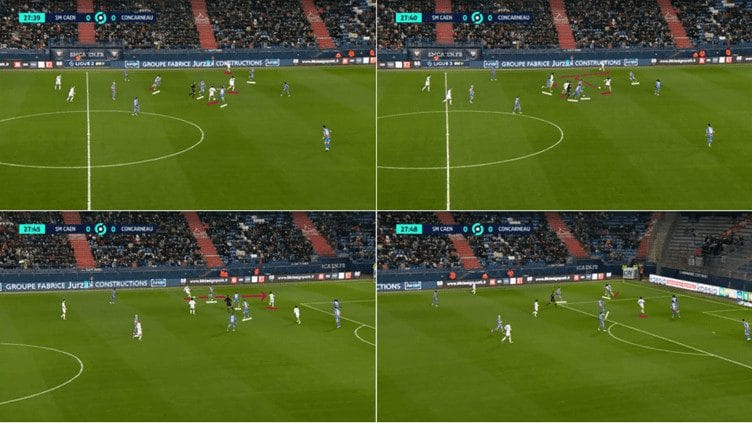
Through a combination of pressuring the opponent and their ability to cover up spaces, Caen have managed to forge a new defensive identity that has undoubtedly helped them get back to winning ways consistently under Seube.
Conclusion
Nicolas Seube’s introduction at Caen has sparked a fantastic run of form. While the Vikings have yet to play a team ahead of them in the current Ligue 2 standings, they’ve beaten the teams they needed to. The stats and their in-game footage suggest that this isn’t merely a flash in the pan; under Seube, Caen have an identity that could see them churn out consistent results and have a fair shot at returning to Ligue 1.
This team looks like it will only continue to improve in attack and in defence, which should set some alarm bells ringing in the upper echelons of their league table.





Comments